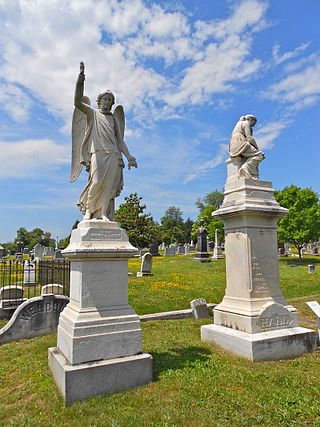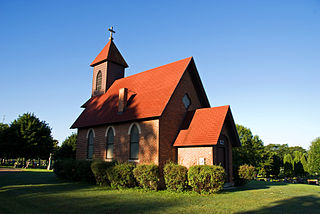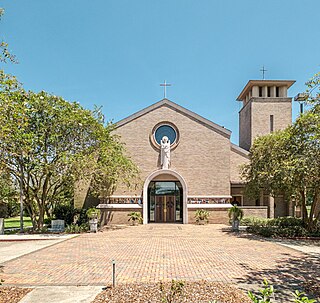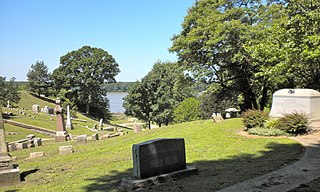
Donaldsonville is a city in, and the parish seat of Ascension Parish in the U.S. state of Louisiana. Located along the River Road of the west bank of the Mississippi River, it is a part of the Baton Rouge metropolitan statistical area. At the 2020 U.S. census, it had a population of 6,695.

Saint Louis Cemetery is the name of three Catholic cemeteries in New Orleans, Louisiana. Most of the graves are above-ground vaults constructed in the 18th and 19th centuries.

Mauna ʻAla in the Hawaiian language, is the Royal Mausoleum of Hawaii and the final resting place of Hawaii's two prominent royal families: the Kamehameha Dynasty and the Kalākaua Dynasty.

Washington Square, originally designated in 1682 as Southeast Square, is a 6.4 acres (2.6 ha) open-space park in Center City, Philadelphia, The southeast quadrant and one of the five original planned squares laid out on the city grid by William Penn's surveyor, Thomas Holme. It is part of both the Washington Square West and Society Hill neighborhoods. In 2005, the National Park Service took over ownership and management of Washington Square, through an easement from the City of Philadelphia. It is now part of Independence National Historical Park.

The Congressional Cemetery, officially Washington Parish Burial Ground, is a historic and active cemetery located at 1801 E Street, SE, in Washington, D.C., on the west bank of the Anacostia River. It is the only American "cemetery of national memory" founded before the Civil War. Over 65,000 individuals are buried or memorialized at the cemetery, including many who helped form the nation and the city of Washington in the early 19th century.

Laurel Hill Cemetery, also called Laurel Hill East to distinguish it from the affiliated West Laurel Hill Cemetery in Bala Cynwyd, is a historic rural cemetery in the East Falls neighborhood of Philadelphia. Founded in 1836, it was the second major rural cemetery in the United States after Mount Auburn Cemetery in Boston, Massachusetts.
Joseph Aristide Landry was a member of the U. S. House of Representatives representing the state of Louisiana. He served one term as a Whig.

St. Landry Catholic Church is a historic Roman Catholic church in Opelousas, Louisiana. It is dedicated to Saint Landry of Paris. The current church building, in Gothic and Romanesque Revival style, was completed in 1909. The church and cemetery were placed on the National Register of Historic Places in the United States on May 5, 1982. By 1792, the church had been renamed from the original title, "Parish Church of the Immaculate Conception of the Post of Opelousas".

The Cathedral of Saint John the Evangelist or La Cathédrale St-Jean, originally called l'Église St-Jean du Vermilion, is the cathedral and mother church of the Roman Catholic Diocese of Lafayette in Louisiana. It was the first parish in Lafayette Parish—founded in 1821—and was designated cathedral upon the erection of the diocese in 1918.

The Ascension of Our Lord Chapel is a historic Russian Orthodox chapel in Karluk, Alaska. Now it is under Diocese of Alaska of the Orthodox Church in America

St. Joseph's Chapel is a historic chapel located in Sacred Heart Cemetery in Eau Claire, Wisconsin. The chapel was used by the German Catholic congregation of Sacred Heart Parish. The Gothic Revival structure was built in 1896 by parishioner Joseph Bemish. It was added to the National Register of Historic Places in 1988 for its architectural significance.

The St. Anne Catholic Church in Napoleonville, Louisiana is a historic Roman Catholic church which was built in 1909. It is located about four blocks inland from Bayou Lafourche at 417 St. Joseph Street, as part of a two-block parcel which includes a contributing rectory (1895) and a contributing cemetery, as well as three non-contributing buildings. It was added to the National Register in 2001.

St. Gabriel Catholic Church is a church parish in St. Gabriel, Louisiana known to have its origins all the way back to 1761. It is noted as the oldest still standing church in the entirety of the Louisiana Purchase. The church parish includes a main church and the Sacred Heart Chapel in the neighborhood of Carville, Louisiana. The church is part of the Diocese of Baton Rouge and its current pastor is Father Charlie Landry. The old parish church building was listed on the National Register of Historic Places on November 27, 1972.

St. Michael's Church Historic District is a historic district in Convent, Louisiana, in St. James Parish, Louisiana. The area was added to the National Register of Historic Places in 1979.

The Public Vault at the Congressional Cemetery in Washington, D.C. is an early classical revival structure built 1832–1834 with funds appropriated by the United States Congress to store the bodies of government officials and members of the public before burial. About 4,600 individuals were temporarily interred in the vault, including three U.S. presidents, First Lady Dolley Madison, and sixteen congressmen who died while serving in office.

Woodland Cemetery is a historic cemetery located at 1020 South Fifth Street in Quincy, Illinois. Planned by politician John Wood and opened in 1846, the cemetery is a product of America's rural cemetery movement of the mid-nineteenth century. The cemetery's grave markers include smaller Victorian monuments and large Gothic Revival and Neoclassical structures. The cemetery was added to the National Register of Historic Places in 2002.

The Historic Cemeteries of New Orleans, New Orleans, United States, are a group of forty-two cemeteries that are historically and culturally significant. These are distinct from most cemeteries commonly located in the United States in that they are an amalgam of the French, Spanish, and Caribbean historical influences on the city of New Orleans in addition to limitations resulting from the city's high water table. The cemeteries reflect the ethnic, religious, and socio-economic heritages of the city. Architecturally, they are predominantly above ground tombs, family tombs, civic association tombs, and wall vaults, often in neo-classical design and laid out in regular patterns similar to city streets. They are at times referred to colloquially as “Cities of the Dead”, and some of the historic cemeteries are tourist destinations.

St Thomas of Canterbury Church, also known as St Thomas's, Rylston Road, is a Roman Catholic parish church in Fulham, central London. Designed in the Gothic Revival style by Augustus Pugin in 1847, the building is Grade II* listed with Historic England. It stands at 60 Rylston Road, Fulham, next to Pugin's Grade II listed presbytery, the churchyard, and St Thomas's primary school, also largely by Pugin, close to the junction with Lillie Road in the borough of Hammersmith and Fulham.





















